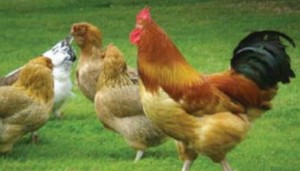 Picture courtesy of Jon Stevens, Growing Gardens for Life
Picture courtesy of Jon Stevens, Growing Gardens for Life
From: TUBOB: Two Years in West Africa with the Peace Corps
It seemed much of our time and effort at home went into food. The chickens created some work. Using a flashlight at night, when the chickens were subdued and didn’t seem to mind being turned upside down, we examined their cloacae. If it appeared dry and unyielding, the hen was likely past producing eggs. She would soon be in the stew pot.
Bruce tried several slaughtering methods, none worked very satisfactorily. Cutting off their heads left a chicken running around, getting sand in the carcass. Bruce heard that if you held a chicken by its head, gave it a quick jerk, the neck would break, thereby killing the bird, but keeping the body intact, avoiding the macabre running around. I watched as he tried it, watched the chicken again run across the compound without a head. This wasn’t how it was supposed to work. Bruce opened his hand and looked at the head with a startled little face looking up at him.
Bruce finally found a good way to slaughter a bird. He held the chicken, gently stroking her neck, speaking softly and once the hen was lulled, he would quickly slice the neck. It made us sad each and every time, but if the chicken was through giving us eggs, we needed to slaughter her. We couldn’t afford to do otherwise.
Preparing a chicken for cooking is a chore: Gutting, de-feathering, and cutting up the bird, all without the benefit of running water was a sticky messy event, then making the stew. We found local chickens too tough for frying or barbecuing.
A hen will lay an egg without a rooster’s input, so to speak. In order to have chicks, of course, a male has to fertilize an egg. Chickens ovulate every day, but a rooster’s sperm lasts several days so that eggs are fertilized as they are formed. Mating can take place every seven to ten days in order to maintain fertilized eggs.
We had one rooster, George, a gift to me while on trek. George took his role very seriously. Every afternoon when we opened the chickens’ gate to let them forage, George crowded ahead, knocking the hens aside. He then stood at the exit, blocking the way, and nailed each hen as she tried to emerge. It was a noisy business with indignant clucking and lots of flying feathers.
Our other big food effort was growing vegetables. We had fair success with gardening, but that also required a lot of work and constant watering, which meant hand-hauling buckets of water from the well. Sometimes we borrowed a wheelbarrow from the UN shop and collected sheep, donkey and cattle droppings to add to our sandy garden soil.
It all took time and energy.
Note: To leave a comment,,click on “Leave a Reply” or “Replies.”


Pingback: Mary E. Trimble: From Eggs to the Pot | Camano Community